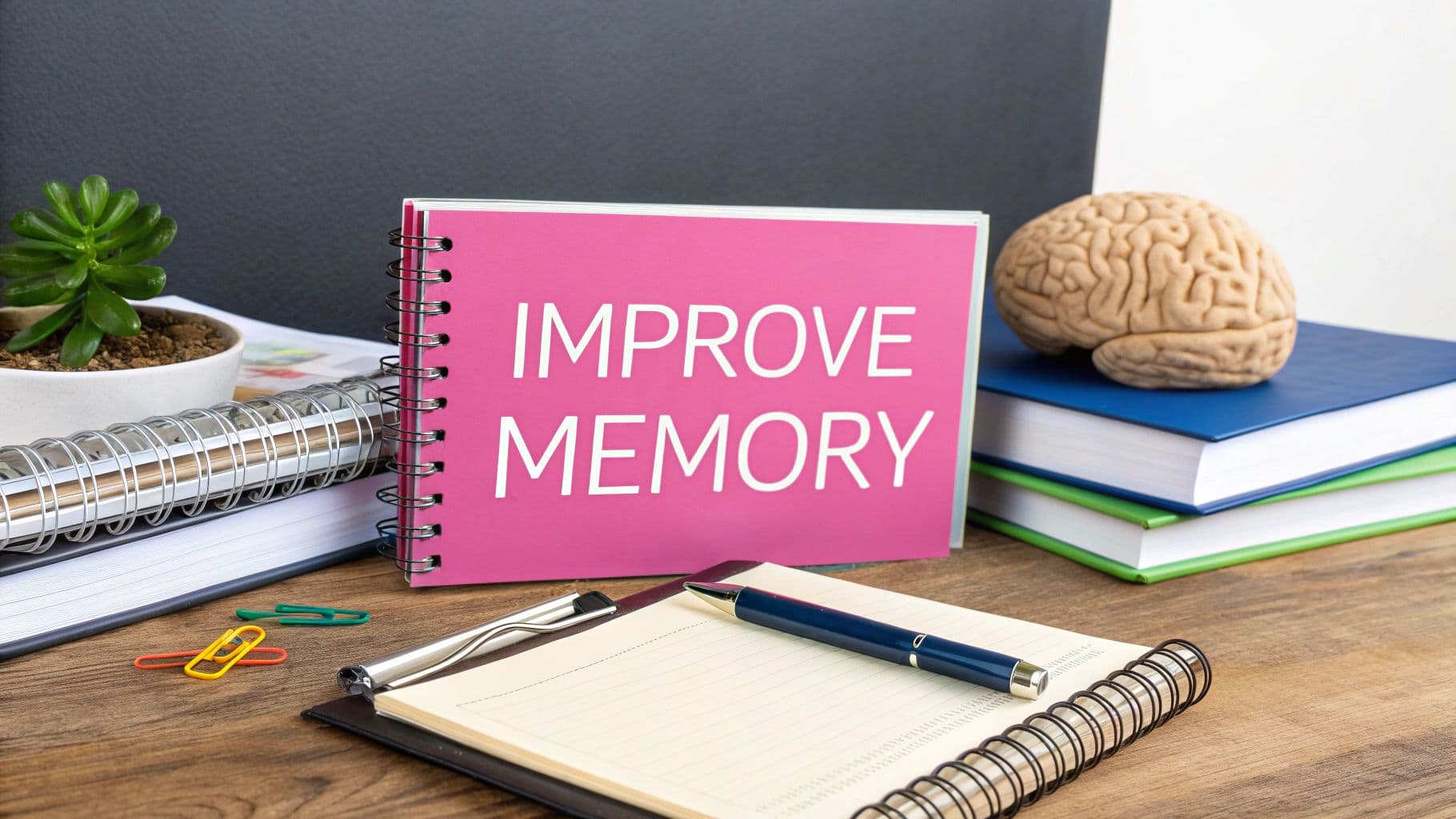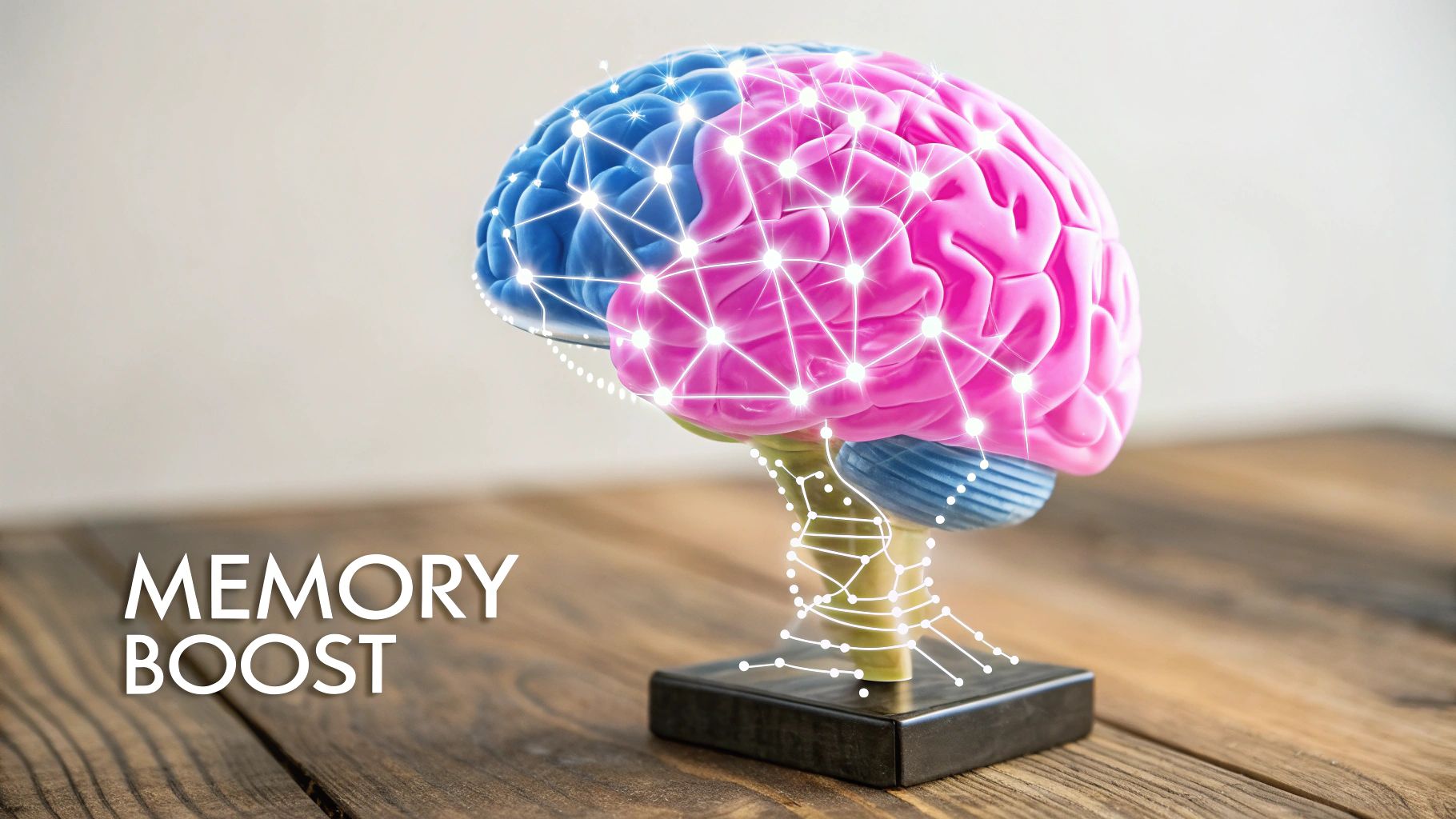
How to Improve Memory for Studying: Expert Techniques That Actually Work
Understanding Your Brain's Memory Systems

To get better at studying, we need to first understand how our brain actually stores and processes information. This isn't complex neuroscience – it's practical knowledge about how memory works that can help you study more effectively by working in harmony with your brain's natural systems.
Short-Term vs. Long-Term Memory: Two Sides of the Same Coin
Your memory has two main components that work together. Short-term memory, also called working memory, functions like a computer's RAM – it temporarily holds information you're actively using. Just as a computer slows down with too many programs running, your short-term memory has limited capacity and can get overwhelmed if you try to process too much at once. This explains why passively reading through notes often fails. Long-term memory, in contrast, is like a computer's hard drive with extensive storage space for information that's been properly processed and stored. This is where you want your study material to end up.
Encoding: The Gateway to Long-Term Retention
Moving information from short-term to long-term memory requires encoding – the process of converting information into a format your brain can store long-term. Just like you need to save a computer file in the right format, simply reading over notes isn't enough for effective encoding. You need to actively engage with the material for it to stick.
Active Engagement: The Key to Unlocking Your Memory Potential
Active recall is essential for improving memory while studying because it forces your brain to retrieve information, which strengthens the neural connections storing that knowledge. It's similar to building muscle – the more you exercise it, the stronger it becomes. For example, instead of re-reading your textbook, create practice questions and test yourself. Research shows this active approach improves learning across different subjects and age groups. Another key technique is spaced repetition – reviewing material at gradually increasing intervals to cement it in long-term memory. For instance, review content right after learning it, then one day later, one week later, and finally after a month. By understanding these basic memory systems and using active learning methods, you can make your study sessions more productive. This foundation helps you get the most out of specific techniques like spaced repetition and active recall, which we'll explore in more detail.
Making Spaced Repetition Your Secret Weapon

When you actively engage with information, you help move it from short-term to long-term memory. This is exactly where spaced repetition shines. The technique works by scheduling reviews at specific intervals that match how our brains naturally store and strengthen memories. Unlike cramming, which overwhelms short-term memory and leads to rapid forgetting, spaced repetition builds lasting recall over time. You'll find yourself spending less time reviewing old material and more time putting your knowledge into practice.
Why Spaced Repetition Works: Combating the Forgetting Curve
The science behind spaced repetition centers on fighting against the forgetting curve. This phenomenon, studied extensively by researchers like Ebbinghaus, shows how quickly we lose information without regular review. Spaced repetition counters this by timing reviews right before you're likely to forget something, which reinforces the memory and slows the rate of forgetting. For example, reviewing material one day after first learning it, then a week later, and finally after a month can significantly boost retention. Research shows this approach can improve memory by up to 200% compared to cramming.
Practical Implementation: Building a Sustainable Study Schedule
You don't need fancy tools to start using spaced repetition effectively. Here's a straightforward approach that works:
- Initial Review: Take a few minutes to go over new information right after learning it. This helps kick-start the memory formation process.
- Day 1 Review: Look at the material again the next day to strengthen your initial understanding and spot any gaps.
- Weekly Review: Come back to it after a week to help move the information into long-term storage.
- Monthly Review: Do a final review after a month to make sure you can easily recall the information when needed.
Leveraging Digital Tools: Optimizing Your Spaced Repetition
While paper and pencil work fine, digital tools can make spaced repetition more efficient. Anki and similar flashcard apps use smart algorithms to show you information right when you need to review it. These tools also track your progress and highlight areas where you need extra practice. Many learning platforms now include spaced repetition features as well. But remember – even a basic spreadsheet can work well for getting started with this method.
Avoiding Common Pitfalls: Consistency Is Key
Success with spaced repetition comes down to sticking with it. It's better to do short, regular review sessions than to skip days and try to catch up later. Don't worry if you struggle to remember things at first – the act of trying to recall information strengthens your memory, even when you don't get it right. Pay attention to what works for you and adjust your review timing based on how challenging the material is. More complex topics might need more frequent review. By making spaced repetition a regular part of your study routine, you'll notice a real difference in how well you remember and understand what you're learning.
Mastering Active Recall Techniques
Active recall is one of the most effective ways to improve your memory when studying. Rather than just reading or highlighting notes, active recall pushes your brain to actively retrieve information, which helps form stronger memory connections. Let's explore practical ways to use this powerful study technique.
Creating Effective Practice Questions
Good practice questions are key to successful active recall. Instead of basic definition questions, create questions that test deeper understanding. For example, rather than "What is osmosis?", ask "How does osmosis help a plant cell maintain water balance? Give a specific example." This approach makes you think more critically and apply concepts in real situations.
Mix up your question types too. Use a combination of multiple-choice, true/false, short answer, and essay questions. This variety helps prepare you for different exam formats and challenges your memory in different ways. Pay attention to how your teachers test the material and create similar practice questions.
Implementing Retrieval Techniques That Stick
Having good questions is just the start – you need to use them effectively. Quiz yourself regularly on the material using flashcards, practice tests, or by covering up your notes and trying to recall key points. This consistent practice strengthens your memory over time.
Don't shy away from topics you find difficult. In fact, spend extra time practicing those challenging areas. If you're having trouble with physics formulas, make multiple practice problems using that formula in different scenarios. Just like building physical strength, your memory for tough concepts improves with focused practice.
Adapting Active Recall for Different Subjects
Active recall works well across all subjects – you just need to adjust your approach. For literature, practice summarizing plot points or analyzing themes. In history, create timelines and compare historical figures or events.
For math and science, work through problems step-by-step and explain your reasoning as if teaching someone else. Even language learning benefits from active recall – try having conversations or writing short stories in the new language. The key is engaging actively with the material rather than passive review.
Research shows the power of this approach. Students using active recall performed 29% better on tests compared to those who just reread their notes. By making active recall a regular part of your study routine, you can significantly improve how well you learn and remember information. The extra effort pays off in better understanding and stronger test performance.
Building Your Personal Memory Palace

Want to make your study techniques even more effective? The Memory Palace method (also called Method of Loci) can help take your learning to the next level. This ancient technique turns abstract facts into memorable visual stories – like creating a mental movie. Memory champions use this powerful approach to master everything from medical terms to historical dates. Let's explore how to apply it to your studies.
Constructing Your Palace: Choosing the Right Foundation
Start by picking a place you know really well – your home, school, a park you visit often, or your daily route to work. The key is selecting somewhere with clear, distinct features you can easily picture in your mind. If you choose your house, think about specific details like the layout of your kitchen or that colorful painting in your hallway. These familiar spots become anchor points where you'll store information. The better you know the location, the easier it will be to find and retrieve your memories later.
Placing Your Memories: The Art of Association
After selecting your location, connect the information you need to remember with specific spots in your palace. The more unusual and vivid these connections, the better they'll stick. For example, when studying biology's Krebs cycle, picture each molecule as a character doing something memorable – maybe citrate is spinning plates on your coffee table while isocitrate dances on your bookshelf. These striking mental images create strong memory hooks that make complex information easier to recall.
The Journey Through Recall: Retrieving Your Information
When test time comes, simply take a mental walk through your Memory Palace. As you move past each location, the associated images and information will naturally come back to you. It's like being your own tour guide through a museum of memories. The more you practice these mental walk-throughs, the stronger your recall becomes as the information settles into long-term memory.
Adapting the Palace: Tailoring the Technique to Your Studies
One of the best things about the Memory Palace technique is how flexible it is. You can adjust it to work with any subject. For history, imagine famous figures having conversations in different rooms. For vocabulary, picture words written in bright colors on furniture or walls. There's no single right way – experiment to find what clicks best with your learning style and subject matter.
Maintaining Your Palace: The Importance of Regular Visits
Just like a real building needs maintenance, your Memory Palace requires regular check-ins to keep memories fresh and clear. Make time to mentally revisit your palaces and strengthen those memory connections. You can even create separate palaces for different subjects or topics. When you combine this visualization technique with spaced repetition, you transform basic memorization into an engaging process that leads to lasting learning. The result is deeper understanding and better recall when you need it most.
Breaking Down Complex Topics Through Chunking

Even after mastering study techniques like spaced repetition and active recall, complex topics can still feel overwhelming. This is where chunking comes in – a practical method for breaking down large subjects into smaller, easier-to-handle pieces. It's similar to organizing a messy room – rather than trying to clean everything at once, you focus on one area at a time, like organizing your desk before moving on to the closet. This systematic approach makes daunting tasks much more manageable.
Why Chunking Works: Cognitive Load Management
Our working memory can only process a limited amount of information at once. Research shows we can typically handle about seven pieces of information (plus or minus two) simultaneously. By grouping related information together into "chunks," we reduce the strain on our working memory, freeing up mental resources to understand complex topics more easily. For instance, we naturally chunk phone numbers into groups rather than trying to remember each digit separately. This same concept helps when studying any subject, whether it's human anatomy or quantum physics.
Practical Chunking Strategies: Building Your Study Blocks
Here are specific ways to effectively chunk information while studying:
- Identify Core Concepts: Begin by pinpointing the main ideas within your topic. These form the foundation of your chunks. For example, when studying the circulatory system, core concepts include the heart, arteries, veins, and capillaries.
- Group Related Information: For each core concept, gather all connected details, facts, and processes. Think of building a complete profile for each main idea.
- Create Visual Representations: Use mind maps, diagrams, or flowcharts to show how your chunks connect. This helps cement relationships between different pieces of information.
- Summarize Each Chunk: Write brief summaries in your own words. This reinforces your understanding and gives you quick reference points for review.
Chunking in Action: Real-World Examples
Take a medical student learning DNA replication. Instead of trying to memorize the entire process at once, they can break it into distinct phases – initiation, elongation, and termination. Each phase becomes its own chunk with specific enzymes, steps, and functions. This makes the whole process easier to grasp. Similarly, law students can break down contract law into elements like offer, acceptance, consideration, and capacity. Each element becomes a manageable study unit, leading to better understanding of contract formation overall.
Collaborative Chunking: The Power of Group Study
Chunking works particularly well in group settings. Students can work together to identify key concepts, organize information, and create shared summaries. This teamwork helps spot gaps in understanding and builds on each person's strengths. Even when studying alone, thinking about how you'd explain a chunked concept to someone else helps strengthen your grasp of the material. By using these chunking strategies, you can turn overwhelming topics into manageable pieces, improving your memory, understanding, and academic results.
Creating Your Ultimate Memory-Boosting System
Like a chef combining ingredients to create the perfect dish, building an effective study system requires thoughtfully combining proven memory techniques. Throughout this guide, we've explored powerful methods like spaced repetition, active recall, the Memory Palace, and chunking. Now it's time to blend these approaches into a personalized system that works for you.
Designing Your Personalized Study System: A Recipe for Success
The first step is understanding how you learn best and what your subjects demand. Do you grasp concepts better through visual aids like mind maps? Perhaps you retain information more effectively by listening to recordings and discussing ideas? Or maybe you learn best through hands-on practice and real-world examples? There's no one-size-fits-all approach.
Match techniques to your subjects strategically. For history courses, the Memory Palace method excels at linking dates and events to vivid mental locations. Quiz yourself on the details stored in each "room" to reinforce both visualization and recall. When studying math or physics, break complex formulas into smaller chunks, master each component, then practice reconstructing the full equation through active testing.
Scheduling Your Study Sessions: Consistency is Key
A structured schedule forms the foundation of effective learning. Instead of cramming for hours, plan shorter focused sessions spread throughout the week. For example, review material right after class, revisit it the next day, then schedule follow-up reviews a week and month later. This spaced approach helps fight forgetting and builds lasting knowledge.
Here's a sample weekly schedule to consider:
| Day | Subject | Technique |
|---|---|---|
| Monday | Biology | Active Recall, Chunking |
| Tuesday | History | Memory Palace, Spaced Repetition |
| Wednesday | Math | Chunking, Active Recall |
| Thursday | Biology | Spaced Repetition |
| Friday | History | Active Recall |
| Saturday | Math | Practice Problems |
| Sunday | Review all subjects | Spaced Repetition |
Adjust this template based on your courses and schedule. The key is maintaining consistency while actively engaging with the material.
Troubleshooting and Adapting Your System: Embracing Flexibility
As you implement your study system, expect to make adjustments. Some techniques will click immediately while others may need modification. Pay attention to what delivers results for you. If the Memory Palace doesn't help with chemistry concepts, try switching to mind mapping or chunking instead.
Finding the right balance between different methods takes time. Start with just one or two core techniques like spaced repetition and active recall. Once those feel natural, gradually add other approaches to your toolkit.
Tracking Your Progress and Celebrating Successes: Stay Motivated
Keep a simple journal or spreadsheet to monitor your study sessions, techniques used, and retention levels. Regular check-ins help identify what's working and what needs tweaking. This reflection process is vital for optimizing your system over time.
Remember to acknowledge your wins, whether it's mastering a tough concept or seeing improved quiz scores. These moments of recognition help maintain momentum and build confidence in your approach. Through continual refinement, you'll develop a study strategy that truly transforms how you learn and remember information.
Ready to take your studying to the next level? Notescast can help convert your notes into engaging video content, making complex topics easier to understand and remember. Try it today to experience a more effective way to learn!
